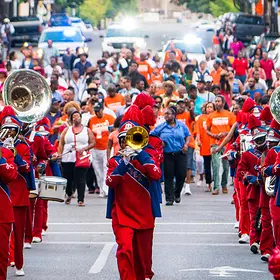President's Note: Illuminating Hidden Figures
Last winter, moviegoers received a valuable history lesson, from the Oscar-nominated movie Hidden Figures, about the African-American mathematicians and engineers who propelled our space program forward but who, until recently, never received the credit they deserved. While Alan Shepard, John Glenn, and Neil Armstrong are all in the history books, all three astronauts got to space and back thanks to Katherine Johnson, a genius who quietly worked wonders with her pencil and slide rule.
I thought about Hidden Figures often as I traveled around the country this past year. At a time when Americans are reflecting anew on the role that history plays in our culture and public spaces, the film—a smash box-office success—illustrates both the important work we still have to do to tell the full and inclusive story of our nation, and the strong desire among many Americans to see that story told.
Indeed, one of the most exciting frontiers in preservation today is seeing diverse stories come to light at last. At the homes of our Founders, such as James Madison’s Montpelier and George Washington’s Mount Vernon, visitors now also learn about those who were enslaved before, during, and after our War of Independence. Colleges such as Harvard, the University of Mississippi, and Rutgers are adding contextual information about the slave labor that helped build their campuses. Last fall, Philadelphia erected its first-ever public statue of an African-American in honor of Octavius Catto, a 19th-century anti-segregation activist. As Mayor Jim Kenney aptly pointed out in an AP interview, “We know more about Rocky—who’s not even a real person—than we know about Octavius, which says a lot.”
Mayor Kenney is right. While we have been making important progress in broadening the record, too many important figures remain hidden within our national narrative. That is why we at the Trust recently formed an African American Cultural Heritage Action Fund. Through this multimillion-dollar campaign, we aspire to double our programmatic efforts in celebrating stories of African-American achievement over the next several years, and to establish a new grant fund to support saving places that reflect significant African-American history.
By drawing attention to remarkable—and still largely unrecognized—places and stories evoking centuries of African-American activism, architecture, and achievement, we hope to fill an important gap in our cultural heritage landscape, inspire a new generation, and further our vision of a stronger, more united America where all of our stories—regardless of race, gender, or sexual orientation—are reflected in the places that surround us.African American Heritage: African American Cultural Heritage Action Fund

We owe it to ourselves, our ancestors, and our future generations to preserve—and share—the full American story. The National Trust and its partners are raising $25 million to create and invest in the largest preservation campaign ever undertaken on behalf of African American history.


